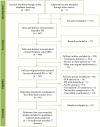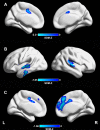Cortical thickness in Parkinson's disease: a coordinate-based meta-analysis
- PMID: 33461168
- PMCID: PMC7906199
- DOI: 10.18632/aging.202368
Cortical thickness in Parkinson's disease: a coordinate-based meta-analysis
Abstract
Parkinson's disease (PD) is a common age-related neurodegenerative disease that affects the structural architecture of the cerebral cortex. Cortical thickness (CTh) via surface-based morphometry (SBM) analysis is a popular measure to assess brain structural alterations in the gray matter in PD. However, the results of CTh analysis in PD lack consistency and have not been systematically reviewed. We conducted a comprehensive coordinate-based meta-analysis (CBMA) of 38 CTh studies (57 comparison datasets) in 1,843 patients with PD using the latest seed-based d mapping software. Compared with 1,172 healthy controls, no significantly consistent CTh alterations were found in patients with PD, suggesting CTh as an unreliable neuroimaging marker for PD. The lack of consistent CTh alterations in PD could be ascribed to the heterogeneity in clinical populations, variations in imaging methods, and underpowered small sample sizes. These results highlight the need to control for potential confounding factors to produce robust and reproducible CTh results in PD.
Keywords: Parkinson's disease; coordinate-based meta-analysis; cortical thickness; seed-based d mapping; surface-based morphometry.
Conflict of interest statement
Figures


Similar articles
-
Cortical thickness in Parkinson disease: A coordinate-based meta-analysis.Medicine (Baltimore). 2020 Jul 31;99(31):e21403. doi: 10.1097/MD.0000000000021403. Medicine (Baltimore). 2020. PMID: 32756136 Free PMC article.
-
Cortical Thickness in Migraine: A Coordinate-Based Meta-Analysis.Front Neurosci. 2021 Jan 6;14:600423. doi: 10.3389/fnins.2020.600423. eCollection 2020. Front Neurosci. 2021. PMID: 33488349 Free PMC article.
-
Pattern of cortical thickness in depression among early-stage Parkinson's disease: A potential neuroimaging indicator for early recognition.Behav Brain Res. 2025 Jul 26;490:115622. doi: 10.1016/j.bbr.2025.115622. Epub 2025 May 2. Behav Brain Res. 2025. PMID: 40319944
-
Cortical thickness in chronic pain: A protocol for systematic review and meta-analysis.Medicine (Baltimore). 2020 Jul 31;99(31):e21499. doi: 10.1097/MD.0000000000021499. Medicine (Baltimore). 2020. PMID: 32756184 Free PMC article.
-
The effects of childhood maltreatment on cortical thickness and gray matter volume: a coordinate-based meta-analysis.Psychol Med. 2023 Apr;53(5):1681-1699. doi: 10.1017/S0033291723000661. Epub 2023 Mar 22. Psychol Med. 2023. PMID: 36946124 Review.
Cited by
-
Focusing on Comorbidity-A Novel Meta-Analytic Approach and Protocol to Disentangle the Specific Neuroanatomy of Co-occurring Mental Disorders.Front Psychiatry. 2022 Jan 18;12:807839. doi: 10.3389/fpsyt.2021.807839. eCollection 2021. Front Psychiatry. 2022. PMID: 35115973 Free PMC article.
-
Evaluation of non-motor symptoms in Parkinson's disease using multiparametric MRI with the multiplex sequence.Front Aging Neurosci. 2025 Jul 16;17:1602245. doi: 10.3389/fnagi.2025.1602245. eCollection 2025. Front Aging Neurosci. 2025. PMID: 40741048 Free PMC article.
-
Gray Matter Volume Abnormality in Chronic Pain Patients With Depressive Symptoms: A Systemic Review and Meta-Analysis of Voxel-Based Morphometry Studies.Front Neurosci. 2022 Jun 6;16:826759. doi: 10.3389/fnins.2022.826759. eCollection 2022. Front Neurosci. 2022. PMID: 35733934 Free PMC article.
-
Structural and neurophysiological alterations in Parkinson's disease are aligned with cortical neurochemical systems.medRxiv [Preprint]. 2023 Apr 5:2023.04.04.23288137. doi: 10.1101/2023.04.04.23288137. medRxiv. 2023. Update in: Ann Neurol. 2024 Apr;95(4):802-816. doi: 10.1002/ana.26871. PMID: 37066346 Free PMC article. Updated. Preprint.
-
Glymphatic dysfunction exacerbates cognitive decline by triggering cortical degeneration in Parkinson's disease: evidence from diffusion-tensor MRI.Brain Commun. 2025 Feb 20;7(1):fcaf029. doi: 10.1093/braincomms/fcaf029. eCollection 2025. Brain Commun. 2025. PMID: 39980740 Free PMC article.
References
-
- Dorsey ER, Elbaz A, Nichols E, Abd-Allah F, Abdelalim A, Adsuar JC, Ansha MG, Brayne C, Choi JYJ, Collado-Mateo D, Dahodwala N, Do HP, Edessa D, et al.. Global, regional, and national burden of Parkinson's disease, 1990–2016: a systematic analysis for the Global Burden of Disease Study 2016. Lancet Neurol. 2018; 17:939–53. 10.1016/S1474-4422(18)30295-3 - DOI - PMC - PubMed
Publication types
MeSH terms
LinkOut - more resources
Full Text Sources
Other Literature Sources
Medical

